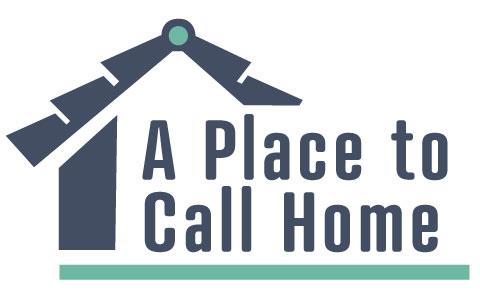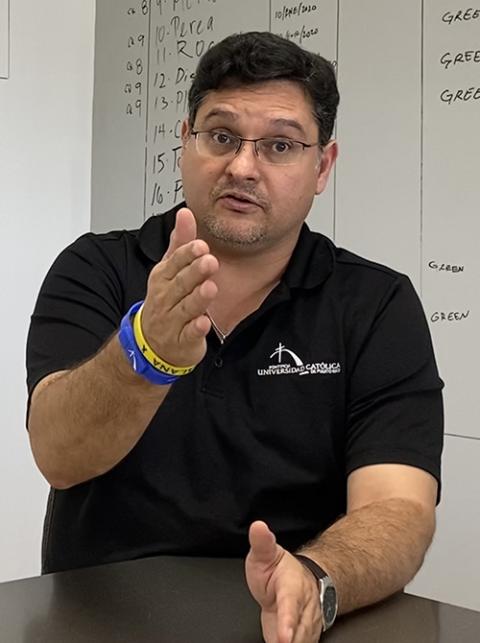
Wanda Rodríguez and her son, Steven, outside their home in Guánica, where Wanda has lived for 46 years. (GSR photo / Soli Salgado)

(GSR logo / Toni-Ann Ortiz)
Editor's note: More than 1.6 billion people worldwide live in substandard housing. Of those, at least 150 million have no home at all. In this special series, A Place to Call Home, Global Sisters Report is focusing on women religious helping people who are homeless or lack adequate shelter. Over the next few months, we will examine how homelessness and a lack of affordable housing affect teens and young adults, families, migrants, the elderly and those displaced by natural disasters and climate change in stories from Kenya, India, Vietnam, Ireland, Puerto Rico, the Philippines, the United States and elsewhere.
The patch of land just off a highway exit between Guánica and Ponce, Puerto Rico, is where Maribel Martínez has her car parked indefinitely. It's also where she's been living for a few weeks — and will live indefinitely.
Since a 6.4-magnitude earthquake rocked the southwest region of the island Jan. 7, she hasn't re-entered her home, leaving behind all her belongings, including identification and medications for her cancer treatment.
"It's been incredibly difficult," Martínez told Global Sisters Report. "I don't sleep. I have panic attacks. I feel so impotent. I've fallen into a crisis and feel like I can't get out. I'm not used to living like this: dirty. My whole life has been changed. ... I keep thinking how I'd rather die of my cancer than buried alive in rubble."
A little over two years into the island's slow recovery following Hurricane Maria in September 2017, the earthquake that struck Puerto Rico was unlike anything it's known since the San Fermín earthquake of 1918. The New York Times reported that the Puerto Rico Department of Housing estimates that roughly 8,300 houses were damaged in the earthquake, with about 2,500 left uninhabitable. Thousands of people have been forced to live in tents until either their homes are repaired or they find a new one.
The "deafening sound" that woke Martínez up at precisely 4:57 in the morning has so haunted her that she sought out a psychologist, she said. "I remember waking up and honestly thinking that my roof would cave on me" before she ran to her neighbor's, crying and empty-handed.
Though she spent a few weeks in a local refuge center for earthquake victims, because of her complicated health conditions, she was told to relocate. She chose to live out of her car so she would not waste gas driving to her various doctors' offices.
The earthquake most affected 16 southern towns, including the cities of Ponce, Guánica, Guayanilla and Yauco. That's where Sr. Mildred Vázquez, who lives in Ponce, takes her ministry.
Vázquez, who belongs to the Siervas Misioneras de la Santísima Trinidad (Missionary Servants of the Most Blessed Trinity), is the director of Ponce's Centros Sor Isolina Ferré. The center works in education, violence prevention, economic development, and community action. Following natural disasters, various committees scout local needs, reaching out to government agencies or collecting donations on behalf of affected families. Even in the midst of a pandemic, their services and outreach have not stopped.
Shalena Rodríguez, who spearheads the center's community outreach in Guánica, had learned of Martínez's case and organized donations to help her buy time as she figures out her next move. Handing her a case of water bottles Feb. 22, Rodríguez assured a tearful Martínez that she was not forgotten.
"We are here, and you are not alone," she told her.
After the earthquake, Martínez's car held nothing but blankets and some snacks. It was through Rodríguez that she received a $50 gift card to Walmart, allowing her to buy a fresh set of clothes and some nonperishable food a few weeks later.
"Never in my life did I think I would have to prepare myself for this, that I'd be living like this," she said. "But I couldn't have prepared because it never occurred to me that I'd ever be living like this."
The people of Guánica, the epicenter of the earthquake, mainly followed one of two paths after Jan. 7. They either fled the town (or Puerto Rico entirely) once their homes or businesses were destroyed, fearful that the town's location over a fault line will mean only more damage to come. Or they live on refuge sites or in their cars or backyards, transforming what remains of their lots into mini campsites with tents serving as alternates to the cracked homes in the foreground.
"The town feels empty, and that causes a lot of economic instability and loneliness for those who chose to stay," Vázquez said, noting that many who owned stores have also chosen to flee. "Even those whose homes weren't badly damaged, now they don't have a grocery store or a pharmacy. They're constantly wondering, what do I do? Should I leave?"
'Any time I feel a tremble, my heart starts racing'
Following Hurricane Maria and again after the earthquake, Centros Sor Isolina Ferré worked with committees of engineers and construction workers to help rebuild homes while Vázquez focused more on their immediate needs, calling agencies on the families' behalf and finding out what services they qualify for or what donations they can receive.
They return to these people not just with items and information, but also with social workers and psychologists to help with the anxiety that strains those traumatized by the earthquake, fearful that their already-cracked home might cave with the slightest shake.
For years, Puerto Rico will experience aftershocks from the Jan. 7 earthquake, feeling smaller earthquakes on a daily basis for several more months, according to the U.S. Geological Survey.
Though none since have compared to the 6.4-magnitude that leveled homes and infrastructure throughout the southwest, Puerto Rico — which USGS notes "lies in a tectonically active region" — trembles anywhere from 20 to 30 times a day, according to Earthquake Track. (Most range close to a magnitude of 3, according to Puerto Rico Seismic Network.)
"A lot of times, the house is safe — engineers have told them it's fine to keep living there — but still, people are too scared," Vázquez said. "They'll sleep outside their homes in tents or their cars because they're afraid of what a tremble can do to their home while they're sleeping."
The night of the earthquake, she said her house "felt like a ship rocking in the ocean." The dining room was wet from the watercooler tumbling over, and the house was pitch-black since the lights had gone out.
"I slept in the living room for a long time after, fully dressed with a backpack by the door, ready to go in case we had to leave in a hurry," she said. "The impacts afterward were very, very intense."
Hurricanes come with warning; islanders are accustomed to taking such precautions with the notice they're given, stocking up on essentials while moving further inland for safety. A ruinous earthquake, on the other hand, happens without notice.
"People are scared," Vázquez said. "They don't know whether there will be another big one when they feel the tremors. They're afraid of the unknown. Those with kids are worried about keeping them safe, but also those who live with elderly because they wouldn't be able to run out of the house if they had to. Their house could be authorized as safe, but if they're that nervous and unsure, they'd prefer to sleep outside their homes."
To ease their anxieties, Vázquez has an engineer check their home for reassurance, "but they still doubt."


Armando Rodríguez Torres (GSR photo / Soli Salgado)
Wanda Rodríguez's home in Guánica was still under repair following Hurricane Maria when the earthquake shook the two-story house in a remote part of the town. She's lived in that house for 46 years, but she hasn't gone back in since Jan. 7.
"For a while, I didn't want to sleep anywhere near here. Any time I feel a tremble, my heart starts racing. ... That night [of the earthquake], it sounded like a literal monster, just incredibly loud and frightening. Every time I feel a tremble, it's like I hear that monster again."
Now, she and her husband, their son and their three young grandchildren sleep in a tiny wooden home right next to their old house, with an outdoor kitchen and a makeshift shower and toilet. Depending on how long donations and construction take, they could live like this for several more months.
"There's no getting used to living like this," she said, adding that she most longs for a bathroom with privacy.
Finding people like Martínez and Rodríguez is what Juan Pablo Díaz Fortes does every day as president of the Volunteer Group for Disaster Relief of Puerto Rico. Once a local community leader pointed him in the direction of Wanda's house and family, he coordinated with people from various ministries — including Shalena Rodríguez of Centros Sor Isolina Ferré — to provide aid, such as building the tiny home where Wanda and her family now live.
Shalena Rodríguez said Wanda's situation right now is typical of many Puerto Ricans along the southern coast, expanding upon their new tiny houses on their land right by their old homes.
"I'm incredibly grateful for these people who lent us a hand," Wanda said. "We spent almost a month sleeping in my van before Juan Pablo came out here to offer help. ... Since it's hard to reach our house, it was the first time we've ever been provided tanks of purified drinking water."
Leaving Wanda's home after dropping off supplies, Vázquez commented that the family was already living in humble conditions when the earthquake struck.
"Within their poverty came more poverty."
The struggles of an economic crisis after disasters
"Even before [Hurricane] Maria, there were a lot of homeless," said Fr. Enrique Camacho, executive director of Caritas of Puerto Rico, which is affiliated with Catholic Charities USA.
The island's economic crisis "has been increasing with the natural disasters, and because we have a big debt in the government, there are a lot of social services that people are not receiving because there are no funds. All of that will lead to more homeless," he said.
According to the U.S. Interagency Council on Homelessness, as of January 2019, Puerto Rico's homeless population on any given day exceeded 2,500, though public school data through the Department of Education estimates that more than 6,700 students experienced homelessness at one point throughout the year.
"Ten years ago, those you saw on the streets were mostly drug addicts," Camacho said. "Now, I can't know who is a drug addict and who is not. But a lot aren't." (After the hurricane, the island also experienced a mass exodus: Pew Research reported a nearly 4% decline in the population.)
According to Camacho, following Hurricane Maria, Caritas coordinated a massive disaster response, partnering with Catholic Charities USA, which donated $8 million, to feed around 700 people a day and with Home Depot, which donated $250,000, to reconstruct homes. Through tears, Camacho recalled receiving $100 from a group of kids in the United States who sent a photo of their lemonade stand with the Puerto Rican flag.
Advertisement
Following hurricanes, more houses may be damaged, but repair is easier, Vázquez said. Houses made of concrete can withstand the winds and water, so the focus is typically on fixing roof damage and windows, as well as replacing belongings with water damage.
"But when the entire house has fallen, it's not nearly as simple," she said.
Hurricanes, however, tend to affect larger chunks of the island at a time, while earthquakes are more concentrated. It's easier for Puerto Rico to band together and provide earthquake relief when just the southwest region needs help than to assist the entire island after a hurricane.
Dioceses throughout Puerto Rico, therefore, have been sending mattresses, water filters, solar lights, tents and other supplies to the Diocese of Ponce, Camacho said. Right after the earthquake, the drive from Ponce to Guánica — typically 25 minutes — could take two hours, "and not just because the roads were reduced to one lane, but because there were a lot of people traveling and wanting to help," he said.
"It's an opportunity to remember we have to take care of our neighbors and be less individualistic."
[Soli Salgado is a staff writer for Global Sisters Report. Her email address is [email protected]. Follow her on Twitter: @soli_salgado.]


















